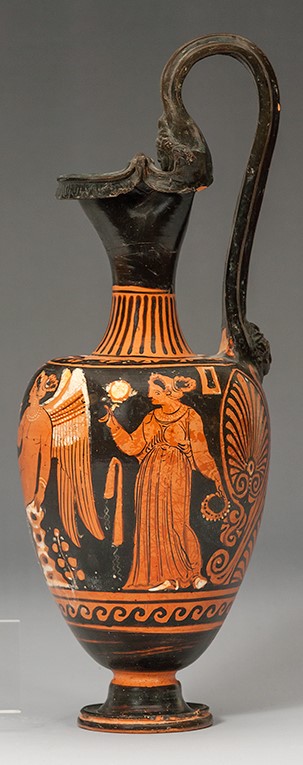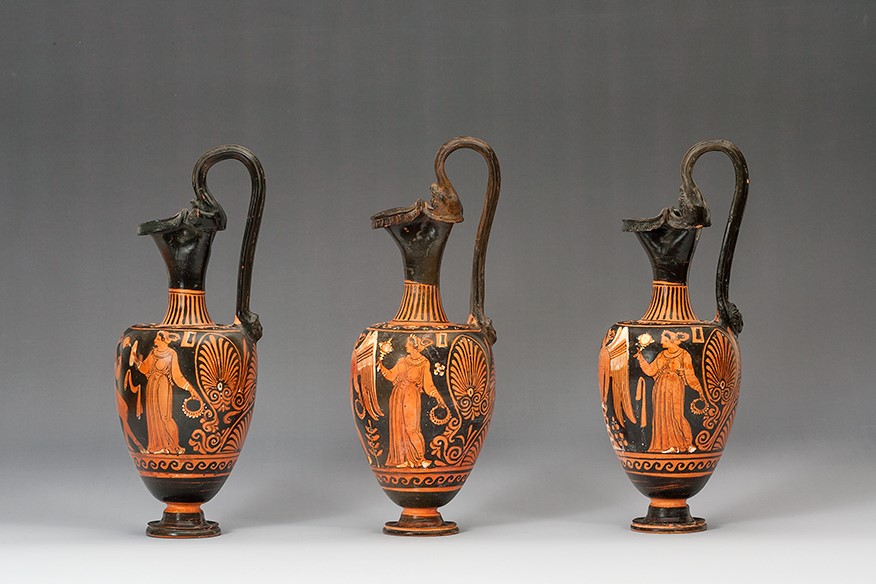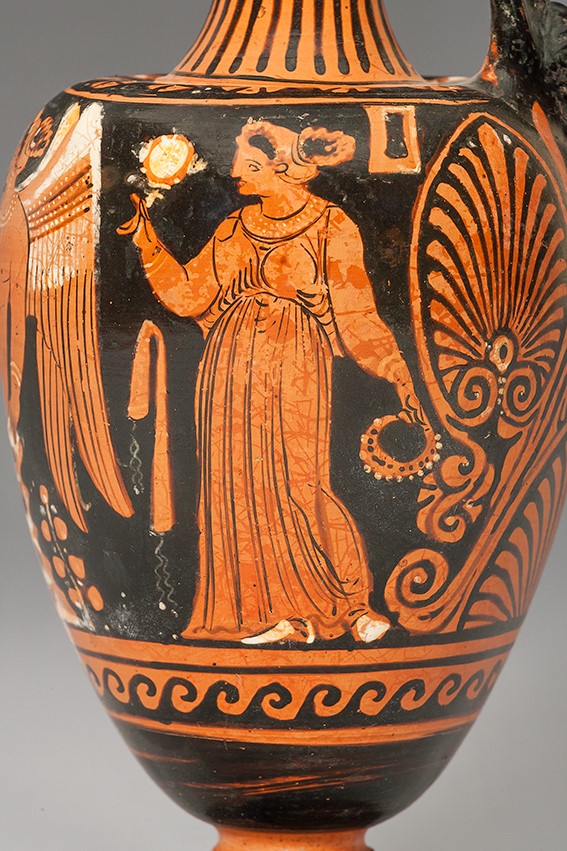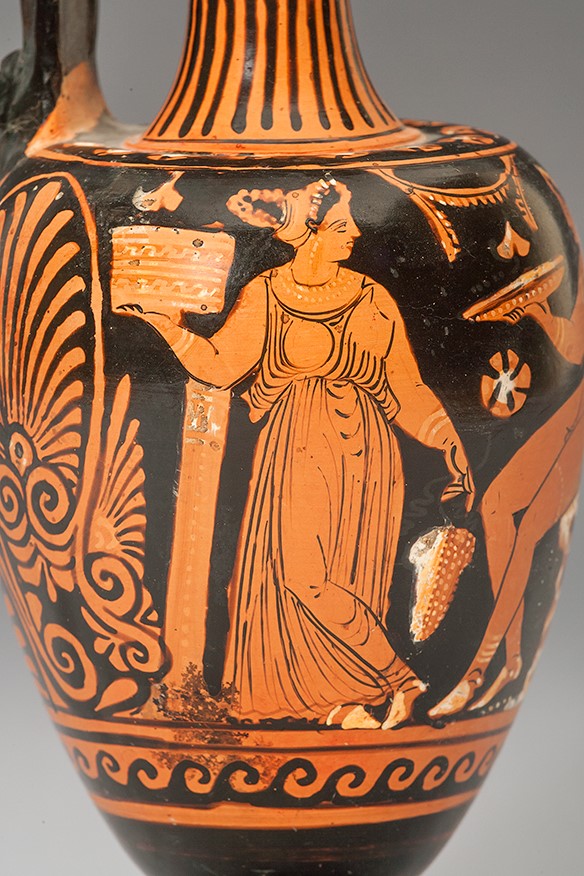Acquisition number: 1965.19
Oinochoe (shape 1).
Intact and in good condition. High, elaborately drawn handle with central groove; at the bottom, a plastic mask of an Amazon and another at the mouth. From the handle onto the back of the mouth come rotelles in the form of plastic female heads. The lip is given a pronounced rim which has impressed egg and dot around the front portion. Narrow neck with a step at the junction with the shoulder. High foot with grooved outer edge; one part of the foot was damaged during manufacture.
On the body is depicted an Eros sitting between two standing women. The woman on the left leans her right elbow on a pillar and stands with her right leg relaxed. She supports a box or basket with her right hand and carries a bunch of grapes in her left. The Eros is seated left on a rock and holds a phiale in his right hand. The right woman faces left and has a mirror in her right hand and a wreath in her left. A sash is drawn in the field before her. Plentiful added white with yellow over for details. At the back, a palmette design; wave pattern below.
On the neck, tongues; on the shoulder, rosettes with white centres and groups of three white dots as filling between. The underside of the foot is reserved. There is no wash inside the vase.
Title: Oinochoe (shape 1) - 1965.19
Acquisition number: 1965.19
Attribution: Menzies Painter.
Author or editor: J.R. Green
Culture or period: West Greek.
Date: c. 340 - 320 BC.
Material: Clay - Terracotta
Object type: Vessels - Jug/wine jug
Dimensions: 100mm (w) × 273mm (h)
Origin region or location: Italy
Origin city: Altamura.
Display case or on loan: 8
Keywords: Apulian, Red Figure, Apulian Tomb Group, Menzies Painter, Eros
J.R. Green with B. Rawson, Catalogue of Antiquities in the Australian National University, A.N.U. (Canberra, 1981) 52; A.D. Trendall and A. Cambitoglou, The Red-Figured Vases of Apulia, ii (Oxford 1982) 826 no. 88, pl. 311, 1; Lexicon Iconographicum Mythologiae Classicae iii (1986) s.v. Eros, no. 488h.
1965.19
Oinochoe (shape 1)
Ht incl. handle 27.3cm; ht (lip) 22.6cm; diam. 10cm.
Intact and in good condition. High, elaborately drawn handle with central groove; at the bottom, a plastic mask of an Amazon and another at the mouth. From the handle onto the back of the mouth come rotelles in the form of plastic female heads. The lip is given a pronounced rim which has impressed egg and dot around the front portion. Narrow neck with a step at the junction with the shoulder. High foot with grooved outer edge; one part of the foot was damaged during manufacture.
On the body is depicted an Eros sitting between two standing women. The woman on the left leans her right elbow on a pillar and stands with her right leg relaxed. She supports a box or basket with her right hand and carries a bunch of grapes in her left. The Eros is seated left on a rock and holds a phiale in his right hand. The right woman faces left and has a mirror in her right hand and a wreath in her left. A sash is drawn in the field before her. Plentiful added white with yellow over for details. At the back, a palmette design; wave pattern below.
On the neck, tongues; on the shoulder, rosettes with white centres and groups of three white dots as filling between. The underside of the foot is reserved. There is no wash inside the vase.
By the Menzies Painter and clearly by the same potter as 1965.20-21. This type of tall, long-necked oinochoe was particularly popular in northern Apulia, in the area of Canosa. Compare the group illustrated in Archaeological Reports 1966-67, 37 fig. 14. See also the two oinochoai of the Menzies Group identified in a private collection in Scotland: D. Ridgway, “Two Menzies Vases in Scotland”, in: J.-P. Descœudres (ed.) Eumousia. Ceramic and Iconographic Studies in Honour of A. Cambitoglou (Mediterranean Archaeology Suppl. 1, Sydney 1990) 227-230, pl. 43.
Mirrors are a common motif in South Italian vase-painting, particularly in scenes depicting women with Eros, youths or satyrs: they were perceived as emphasising the erotic but they are found, too, in funerary contexts. For a general study of their use, see L. Bahrnsiefen, Die Bedeutung des Spiegelbildes als ikonographisches Motiv in der antiken Kunst (Tübingen 1990). On funerary conexts, see H. Cassimatis, “Le miroir dans les représentations funéraires apuliennes”, Melanges d’Archéologie et d'Histoire - Antiquité 110, 1998, 297-350. For a broader interpretation, see F. Frontisi-Ducroux and J.-P.Vernant, Dans l’œil du miroir (Paris 1997). Wreaths too are very common. They are held or worn by many figures, and since they were worn on festive occasions, their depiction on the vases supplies a context for the activity depicted. See in general M. Blech, Studien zum Kranz bei den Griechen (Berlin 1982).
For the box or basket carried by the woman on the left, compare the one carried by the Eros on 1965.20, a woman on the mug 1965.24, or the Eros on the kantharos 1965.30, and then the one carried by the terracotta figurine 1975.18. Note too the objects associated with the deceased woman on the much later grave stele 1989.01, conventionally identifying her as a beautiful, educated, mother. They all symbolise the character of the figures. A fascinating example is to be found on an Attic red-figure neck-amphora nowadays in Corpus Christi College, Cambridge
J.R. Green with B. Rawson, Catalogue of Antiquities in the Australian National University, A.N.U. (Canberra, 1981) 52; A.D. Trendall and A. Cambitoglou, The Red-Figured Vases of Apulia, ii (Oxford 1982) 826 no. 88, pl. 311, 1; Lexicon Iconographicum Mythologiae Classicae iii (1986) s.v. Eros, no. 488h.
Australian National University.



